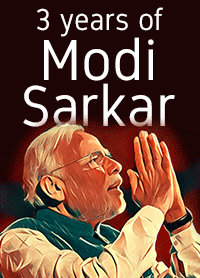Fiscal discipline has been maintained but toxic assets worth Rs 7 crore are a massive headache

As the Narendra Modi govt completes three years in office on May 25, we bring you a series of reports to capture the journey so far.
Jobs, reforms, achhe din (good days) - Narendra Modi promised this and more as he captured India’s imagination, particularly its youth, in the run up to the 2014 Lok Sabha polls.
Three years hence, the report card is a mixed one. Manufacturing shows little signs of revival. Exports are looking up in recent months but largely due to a statistical illusion - of low exports in the same month of the previous year.
Agrarian distress remains despite government efforts, particularly to improve irrigation. The elephant in the room is the sharp dip in job growth in the past three years.
Attribute it to the intoxicating public discourse of Hindutva, not a single allegation of corruption against the government and a discredited Opposition leadership, but much of India continues to be in thrall of Prime Minister Modi’s promise of hope, even nearly 1,100 days after he was sworn in on May 26, 2014.
The recent victory in Uttar Pradesh has only added to his popularity.
 This is rare in the history of democratic India. Neither Indira Gandhi after her famous 1971 electoral win, nor Rajiv Gandhi after the landslide victory of 1984 were afforded such mass popularity after three years in power.
This is rare in the history of democratic India. Neither Indira Gandhi after her famous 1971 electoral win, nor Rajiv Gandhi after the landslide victory of 1984 were afforded such mass popularity after three years in power.
The biggest proof of Modi’s popularity was demonetisation, whose gains are unclear even six months later but most voters are convinced it benefitted the poor and bled the rich.
However, the first majority government in 30 years was expected to take courageous economic decisions that allegedly weak-kneed coalition governments of the last few decades couldn’t.
It isn’t that reforms have not been carried out, but these have been neatly repackaged as garib kalyan, or welfare of the poor.
Even the goods and services tax (GST), the biggest tax reform since Independence, has been sold as garib kalyan.
Official data for the three years of the government presents a mixed picture. A strong positive has been Finance Minister Arun Jaitley’s ability to maintain fiscal discipline.
Fiscal deficit as a percentage of gross domestic product (GDP) has come down from 4.5 per cent in 2013-14 to 3.5 per cent in 2016-17, even as the government and state-owned companies have borne the burden of capital spending.
Gross fixed capital formation grew from 2.1 per cent in 2013-14 to 6.1 per cent in 2015-16. The lack of private sector spending is estimated to have pushed that growth rate down to 0.6 per cent in 2016-17.
Retail inflation has been kept under the upper limit of the Reserve Bank of India’s target band, and in fact dropped to 2.99 per cent in April, while GDP growth is projected to be 7.1 per cent for 2016-17 in spite of demonetisation.
However, dealing with nearly toxic assets worth Rs 7 lakh crore in the banking system remains the government’s biggest economic challenge in the coming two years of its tenure.
Gross non-performing assets (NPAs) as a percentage of gross advances rose from 3.2 per cent in 2012-13 to 8.4 per cent in 2015-16 for banks. Gross bank credit growth dropped sharply from 14 per cent in 2013-14 to 7.4 per cent in 2016-17.
“The issue of NPAs is what the government needs to deal with within this electoral cycle,” said Soumya Kanti Ghosh, chief economist, State Bank of India.
Ghosh said the pace of reforms by the government in its first three years has gone from incremental to big bang. “From a thousand small steps, the government has moved to big-ticket reforms like the GST and bankruptcy laws,” he said.
But given the global situation in certain industries, job creation is and will continue to be slow. “Given the pace of automation and consolidation in sectors such as financial services and information technology, job creation is difficult. The government has tried to give impetus to entrepreneurship through schemes such as MUDRA and Start-up India,” he said.
The government doesn’t dispute the figures on job growth but claims that its MUDRA Yojana, with about 70 million beneficiaries, has encouraged entrepreneurship that the data is unable to capture.
Not that the government is not worried at the demographic dividend turning into a nightmare. Already, social chaos in the form of cow vigilantism and low-scale caste and communal conflicts has become a concern. Recent caste clashes in Saharanpur, in western Uttar Pradesh, portend ill.
In an effort to boost job growth and respond to protectionist narratives in western economies, the government is mulling a mega policy to ensure local procurement of material in key sectors.
After a poll defeat in Delhi in February 2015, opposition to the government’s land acquisition Bill and criticism about it being a “suit-boot ki Sarkar” (a government of and for moneybags) the PM embraced the electorally safer garib kalyan, or welfare of the poor, slogan with a vengeance by mid-2015 and junked his call for change and reform.
The biggest example of the Centre veering away from reform to populism, at least in its discourse, is the Mahatma Gandhi National Rural Employment Guarantee Act (MGNREGA). Within months of his Lok Sabha victory, Modi derided in Parliament the scheme as a “living monument” to the failure of the UPA’s populist policies.
But the 2015 Delhi and then Bihar defeats changed that. According to data, the highest ever spend on the scheme has been under the Modi government. Spending on MGNREGA has jumped from about Rs 32,500 crore (Rs 325 billion) in 2014-15 to revised estimates of Rs 47,500 crore (Rs 475 billion) in 2016-17, a staggering increase of 46 per cent.
For 2017-18, the budgeted allocation stands at Rs 48,000 crore (Rs 480 billion). However, cases of delay in wage payment are rampant and the Centre is said to be understating the compensation it pays to workers for such delays.
In three of the four Budgets presented by this government, particularly its 2017-18 one, has a pro-poor theme.
The Budget lowered the income tax for those earning less than Rs 500,000 a year, cut tax on companies - aimed at the micro, small and medium enterprises (MSME) sector - earning less than Rs 50 crore and announced sops for the rural sector.
This agenda has been extended by the BJP state governments, particularly Uttar Pradesh, which waived off farm loans worth Rs 36,000 crore in April.
But poor industrial activity, the likely impact of the GST roll-out on the MSME sector, which is the largest employment provider and already reeling under the impact of demonetisation, and international economic conditions, make job growth the biggest challenge for the Modi government in the next two years.
If Indira Gandhi won the 1971 elections on the back of her “Garibi Hatao”, remove poverty, slogan, Modi and the BJP have made “Garib Kalyan” their leitmotif in the run up to the 2019 polls.
To Modi’s advantage, there isn’t a single leader in the Opposition who currently measures up to him in the public imagination. Then, there is a growing acceptance of the Hindutva agenda, including the promise of a Ram temple in Ayodhya.
But politics has a habit of changing quickly, as Indira Gandhi discovered by 1973. By the seventh year of her prime ministerial tenure and within two years of she having led India to a famous victory over Pakistan in the Bangladesh war, price rise and joblessness had youth in several parts of India on the roads.
Photograph: PTI Photo











